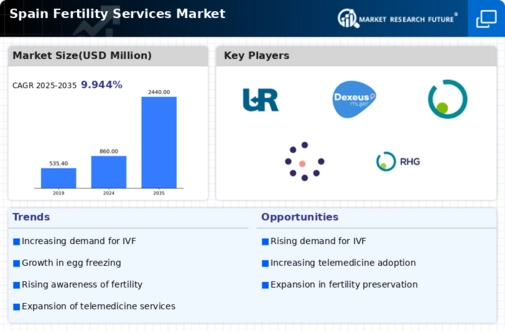Rising Infertility Rates
The The fertility services market in Spain is experiencing growth due to rising infertility rates among couples. in Spain is experiencing growth due to rising infertility rates among couples. Recent data indicates that approximately 15% of couples in Spain face difficulties in conceiving, which has led to an increased demand for assisted reproductive technologies. This trend is further exacerbated by lifestyle factors such as delayed childbearing, obesity, and environmental influences. As more individuals seek solutions, fertility clinics are expanding their services to accommodate this growing need. The market is projected to reach a valuation of €1.5 billion by 2026, reflecting a compound annual growth rate (CAGR) of around 8%. This rising demand for fertility services is likely to drive innovation and competition within the industry.
Growing Public Awareness and Advocacy
Public awareness regarding fertility issues is on the rise in Spain, which is positively influencing the fertility services market. Advocacy groups and educational campaigns are working to destigmatize infertility and promote available treatment options. As a result, more individuals are becoming informed about their reproductive health and the services available to them. Surveys indicate that nearly 60% of the population is now aware of various fertility treatments, compared to just 40% a decade ago. This growing awareness is likely to lead to increased demand for fertility services, as individuals feel more empowered to seek assistance when facing challenges in conception.
Cultural Shifts Towards Family Planning
Cultural attitudes towards family planning are evolving in Spain, contributing to the growth of the fertility services market. Younger generations are increasingly prioritizing career development and personal goals before starting families, leading to delayed childbearing. This shift has resulted in a higher demand for fertility services as couples seek assistance later in life. Data suggests that the average age of first-time mothers in Spain has risen to 32 years, which correlates with increased reliance on fertility treatments. As societal norms continue to change, the fertility services market is likely to adapt, offering tailored solutions to meet the needs of this demographic.
Advancements in Reproductive Technologies
Technological innovations are significantly impacting the fertility services market in Spain. The introduction of advanced reproductive technologies, such as in vitro fertilization (IVF), preimplantation genetic testing (PGT), and cryopreservation, has enhanced success rates for couples seeking assistance. Clinics are increasingly adopting these technologies to improve patient outcomes, which has led to a rise in successful pregnancies. For instance, the success rate of IVF in Spain has improved to approximately 40% per cycle, making it a viable option for many couples. As these advancements continue to evolve, they are expected to attract more patients to fertility services, thereby expanding the market further.
Increased Accessibility of Fertility Treatments
The fertility services market in Spain is benefiting from improved accessibility to fertility treatments. Many private and public healthcare providers are expanding their offerings, making services more available to a broader population. Additionally, the introduction of financing options and insurance coverage for fertility treatments has made these services more affordable for many couples. Recent statistics indicate that around 30% of fertility treatments are now covered by health insurance, which has encouraged more individuals to seek help. This increased accessibility is expected to drive market growth, as more couples are likely to pursue fertility services without the burden of financial constraints.

















Leave a Comment